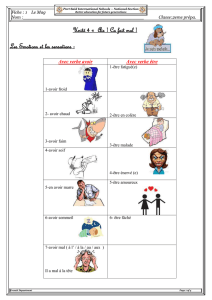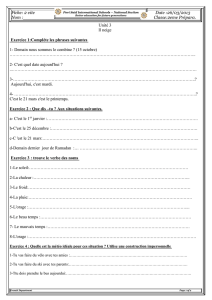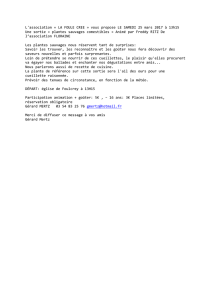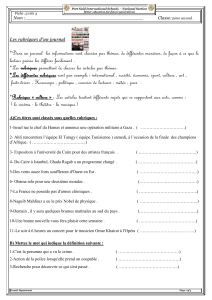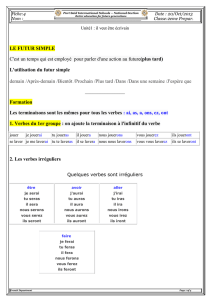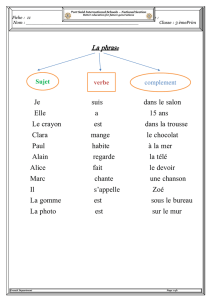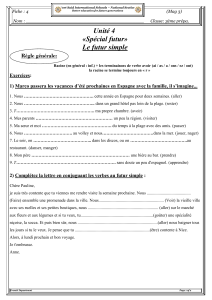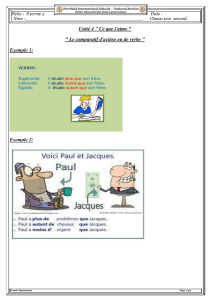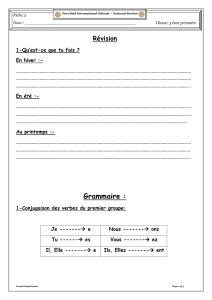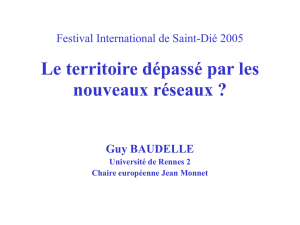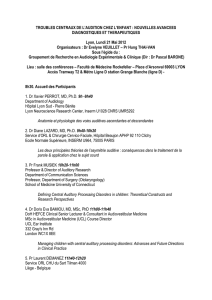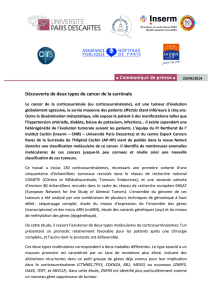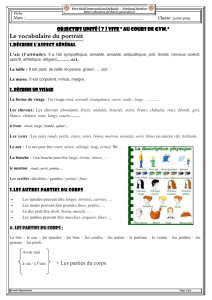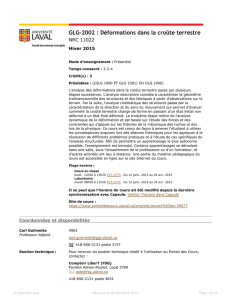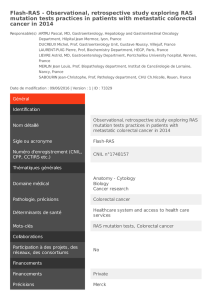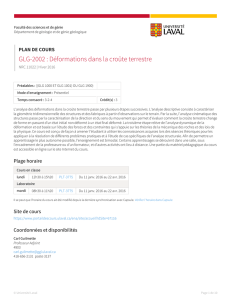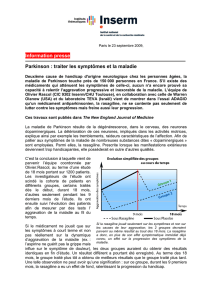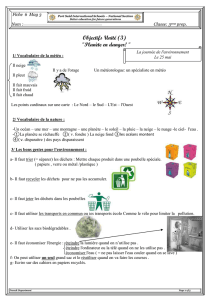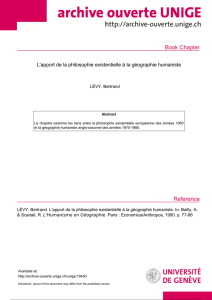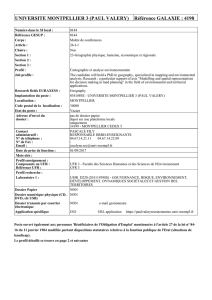Dias nummer 1
publicité
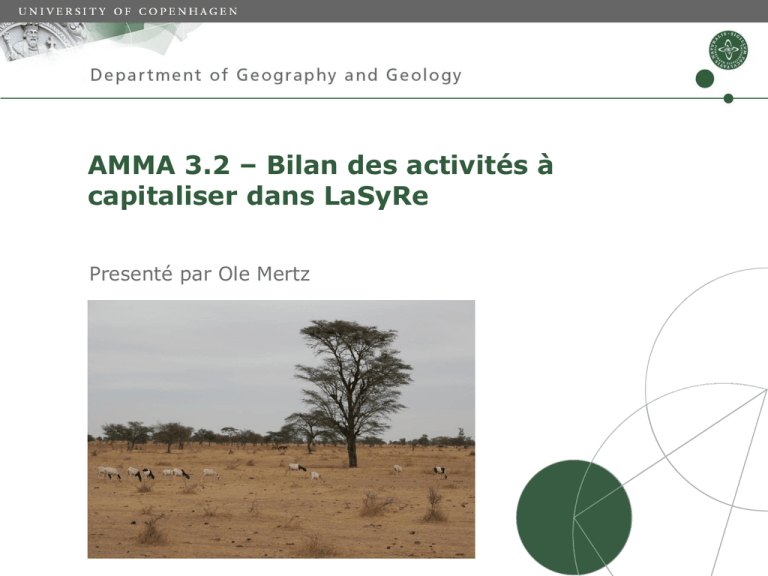
AMMA 3.2 – Bilan des activités à capitaliser dans LaSyRe Presenté par Ole Mertz Department of Geography & Geology Partenaires dans AMMA WP 3.2 • • • • • • • • • • • • • University of Copenhagen, Denmark Université Cheikh Anta Diop de Dakar, Senegal University of Montreal, Canada Centre de Suivi Ecologique, Senegal Université de Bamako, Mali 2ie, Ouagadougou, Burkina Faso Université de Ouagadougou, Burkina Faso Université Abdou Moumouni, Niamey, Niger University of Jos, Nigeria Université Catholique de Louvain, Belgium CNR-IBIMET, Italy CIRAD, France University of Leeds, UK Sites avec <500 mm Department of Geography & Geology Méthodes 1247 questionnaires au niveau ménage/unité de production Ca. 40 entretiens de groupes Analyse de l’occupation des sols (à finir) Department of Geography & Geology Base de données AMMA WP3.2 Department of Geography & Geology Department of Geography & Geology Department of Geography & Geology Department of Geography & Geology Guide d’entretien I. Situation générale dans le village • Faire un profil historique sur les événements majeurs ayant affectés la vie des populations locales • Aspects positifs et difficultés de la vie dans le village • Hiérarchisation des changements et leurs causes dans la vie du village II. Changement et variabilité climatique • Perception du changement et de la variabilité climatique • Impacts du changement et variabilité climatique • Adaptation aux changements et variabilité climatique • Politiques et interventions extérieures III.L’évolution de l’utilisation des terres agricoles IV. L’évolution de l’utilisation de l’espace pastorale V. Changements de la force de travail locale (échelle village) VI. Ressources forestières VII.Ressources en eau VIII.Ressources halieutiques (pêche) Department of Geography & Geology Department of Geography & Geology 90 decreased stable 100 90 80 70 60 50 40 30 20 10 0 Total increased decreased stable 400-500 mm 500-700 mm 700-900 mm decreased stable increased decreased stable 400-500 500-700 increased decreased stable Total increased 50 40 30 20 10 0 decreased stable 500-700 700-900 decreased stable Total Livestock resting areas 100 90 80 70 60 400-500 Total increased 400-500 mm 500-700 mm 700-900 mm Total Total % of households 100 90 80 70 60 50 40 30 20 10 0 stable 100 90 80 70 60 50 40 30 20 10 0 Sheep % of households % of households Maize 700-900 decreased Livestock corridors 100 90 80 70 60 50 40 30 20 10 0 Total increased 400-500 mm 500-700 mm 700-900 mm Total % of households increased % of households % of households 100 90 80 70 60 50 40 30 20 10 0 400-500 mm 500-700 mm 700-900 mm 100 90 80 70 60 50 40 30 20 10 0 Cattle Sorghum 400-500 mm 500-700 mm 700-900 mm % of households increased % of households % of households 100 90 80 70 60 50 40 30 20 10 0 400-500 mm 500-700 mm 700-900 mm Permanent pasture Ground nut Pearl millet 100 90 80 70 60 50 40 30 20 10 0 increased decreased stable 400-500 mm 500-700 mm 700-900 mm Total Department of Geography & Geology Decreasing income crop prod. Decreasing income livestock Decreasing production of pearl millet 100 100 100 80 80 100 80 80 60 60 Decreasing production of maize 60 60 40 40 40 40 20 20 20 20 0 0 1 2 3 0 4 1 Decreasing cattle holdings 2 3 4 0 1 Decreasing sheep holdings 2 3 4 1 Decreasing permanent pasture 100 100 100 80 80 80 80 60 60 60 60 40 40 40 40 20 20 20 20 0 1 2 3 0 4 Decreasing livestock corridors 1 2 3 4 100 100 80 80 60 60 2 3 4 1 Decreasing livestock resting areas 100 100 80 80 60 60 40 40 40 20 20 20 20 0 0 0 0 2 3 4 1 2 3 4 1 2 3 Facteurs climatiques 1: 400-500 mm 2: 500-700 mm Autres facteurs 3: 700-900 mm 4: Total 4 2 3 4 Increasing livestock resting areas 40 1 4 0 1 Increasing livestock corridors 3 Increasing permanent pasture 100 0 2 1 2 3 4 Department of Geography & Geology Perceptions des causes de réduction de la production du petit mil 50 % of households (Pearl millet) 45 40 35 30 400-500 mm 25 500-700 mm 20 700-900 mm 15 Total 10 5 0 en if ci in Ra f su n ll i fa st Pe e inf t on a ti sta nim als er S lf oi it til yd d se a re ec ty er v o d d d ed se se se s a a a a e e e e P cr cr cr cr e e e n d i d r s td ed er n r z ce ou i e i u l r b t i l rt La tp ipm icu u u Fe r p q g In le ra a o r f ltu nd ir cu La Ag d se a re ec ily Liv e sto c sto c ve rt y t he ft de fic i kt Po ee d kf sto c at e ale nt ks na de qu ei Liv e Pa stu r Liv e ea th fic ie kd cr ea se d sto c in is e as es kD ns uf fa ll i Liv e ed s sto c ne Ra in Fa m Liv e % of households Department of Geography & Geology Perceptions des causes de la réduction des animaux 30 25 20 15 10 400-500 mm 500-700 mm 5 700-900 mm 0 Total Department of Geography & Geology Perceptions des causes de réduction du pâturage permanente 70 60 % of households 50 40 400-500 mm 30 500-700 mm 20 700-900 mm 10 Total La n df or pa stu re de cr ea se d n re st at io De fo at e ei na de qu nt Pa stu r f ic ie Ra in pu l Po fa ll i ni at io ex ra l ltu Ag ric u ns uf nc pa ns io n re as e 0 Department of Geography & Geology Mesures d’adaptation aux impacts négatifs sur l’agriculture % of households stating adaptation measure Agriculture (crops) 25 20 15 400-500 10 500-700 5 700-900 Total 0 t d g d se n se on on or in ed i u i a o ve ce on t t ed i p k n i h t o e u a a v p t e o r c r a t d o r p su rd igr ov of ica rv es nu pr ro r f m a t pu r e t i i a M n p s n s G o m n e M ds od ef er tio si si on all m v e o R f a e c p i n e F z c n r i o d i r S li ct d te Cr ve Ra rti a a o o r e o w F p G ih al nd el r a v u i li L lt So ic u r Ag e ay r P r ils so Liv e tro Go v ra l ale n m en ts up po rt Fo dd er st or ag e es ta tio Pr ay er ks e s m an c sto c Re fo r Liv e % of households stating an adaptation measure m en ts sto ck re s id ue ple Tr an sh u ltu er n Ag ric u ive lo fl de rc om co n od kf ar y sto c Ve te rin Department of Geography & Geology Mesures d’adaptation aux impacts négatifs sur l’élevage Livestock 50 45 40 35 400-500 mm 30 25 500-700 mm 20 15 700-900 mm 10 Total 5 0 Department of Geography & Geology Publications de AMMA 3.2 Barbier, B., Yacouba, H., Karambiri, H., Zorome, M. and Somé,B. (2009). Human Vulnerability to Climate Variability in the Sahel: Farmers’ Adaptation Strategies in Northern Burkina Faso. Environmental Management, 43(5): 790-803. Lambin E.F., Mertz O., Rasmussen K., Reenberg A., D’haen S., Nielsen J., Scenarios on the future of the African Sahel, Global Environmental Change, forthcoming. Mbow, C., Mertz, O., Sylla, A.D., Rasmussen, K., Reenberg, A. (2008): Environmental change and local adaptation strategies in Eastern Saloum-Senegal. Global and Planetary Change 64, 210-221. Mertz, O., Mbow, C., Nielsen, J.Ø., D’haen, S., Diouf, A., Zorom, M., Diallo, D., Barbier, B., Dabi, D., Moussa, I.B., Rasmussen, K., Reenberg, A., Lambin, E., Genesio, L., Sandholt, I. Agriculture and climate vulnerability in the Sudan-Sahel region of West Africa. Atmospheric Science Letters, forthcoming. Mertz, O., Halsnæs, K., Olesen, J.E., Rasmussen, K. (2009a): Adaptation to climate change in developing countries. Environmental Management 43(5): 743-752. Mertz, O., Mbow, C., Reenberg, A., Diouf, A. (2009b): Farmers’ perceptions of climate change and agricultural adaptation strategies in rural Sahel. Environmental Management 43(5): 804-816 Mertz, O., Mbow, C., Nielsen, J.Ø., Maïga,A., Diallo, D., Reenberg, A., Diouf, A., Barbier, B., Bouzou Moussa, I., Zorom, M., Ouattara, I., Dabi, D. Climate factors play a limited role for past adaptation strategies in West Africa. Submitted to Ecology and Society. Nielsen, J.Ø., Reenberg, A. (2009). Cultural barriers to climate change adaptation: A case study from Northern Burkina Faso. Global Environmental Change. doi:10.1016/j.gloenvcha.2009.10.002 Nielsen, J.Ø., Reenberg, A. (2009). Temporality and the problem with singling out climate as a current driver of change in a small West African village. Journal of Arid Environments. doi:10.1016/j.jaridenv.2009.09.019 Nielsen J. O. (2009). Drought and marriage: Exploring the interconnection between climate variability and social change through a livelihood perspective. pp 159177 in Hastrup, K. ed. The Question of Resilience Social implications of environmental changes. The Royal Danish Academy of Sciences and Letters, Copenhagen. Reenberg, A. (2009). Embedded flexibility in coupled human-environmental systems in the Sahel: Talking about resilience. Pp. 132-158 n Hastrup, K. ed. The Question of Resilience Social implications of environmental changes. The Royal Danish Academy of Sciences and Letters, Copenhagen. Department of Geography & Geology Numéro spécial de Cahiers Agricultures proposé No Titre Auteurs 1 L’adaptation aux changement et variabilité climatique dans les espaces ruraux d’Afrique de l’Ouest Cheikh Mbow, Bruno Barbier, Ole Mertz 2 Perception des changements climatiques Ole Mertz, Sarah D’haen, Ibrahim Bouzou Moussa, Mahaman Moustapha Adamou, Evariste Da Dapola, Daniel Dabi, Abdou Maiga, Cheikh Mbow, Bruno Barbier 3 Évolution de l’élevage face à la variabilité climatique Alioune Ka, Malicki Zorom, Waziri Mato Maman, Drissa Coulibaly, Kjeld Rasmussen, Abdoulaye Diarra 4 Ressources forestières Cheikh Mbow, Awa Diouf, Ole Mertz, Alioune Ka, Drissa Diallo, Ibrahim Bouzou Moussa, Abdou Maiga 5 Vulnérabilité et adaptation à la variabilité climatique : Genre et vie sociale Awa Diouf, Pierre Cissé, Jonas Ø. Nielsen, Abdou Maiga 6 Migrations et variabilité climatique Pierre Cissé, Bruno Barbier, Malicki Zorom, Awa Diouf, Abdou Maïga, Jonas Østergaard Nielsen 7 Typologies des stratégies d’adaptation – Malicki Zorom, Bruno Barbier, T.P. Zoungrana, Ole Mertz 8 Évolution de l’agriculture pluviale dans un contexte de variabilité climatique – Drissa Diallo, Evariste Da Dapola, Alioune Ka, Abdou Maiga, Malicki Zorom, Awa Diouf 9 Irrigation et variabilité climatique – Bruno Barbier, Bio Tourou, Hamma Yacouba, Malicki Zorom 10 Les politiques et stratégies d’adaptation à la vulnérabilité climatique au Sénégal Aissiatou Niang War, Aminata Ndiaye, Cheikh Mbow, Jacques André Ndione, Amadou Tahirou Diaw Department of Geography & Geology Conclusions Sur la base des perceptions des paysans, la situation au Sahel est la suivante : • • • • • • • La production des cultures pluviales a diminué – mais pas plus que dans les autres zones, et parfois moins (sorgho) Les cultures pluviales reste importantes pour l’économie - mais moins que dans les zones Les effectifs de bétail ont diminué – mais reste important dans l’économie Les autres sources de revenue sont plus importants au Sahel par rapport aux autres zones Les espaces pastoraux sont restés stables ou augmentés Les causes des réductions de la production céréalière sont souvent liées au facteurs climatiques (50% des cas) Les causes des autres changements ont peu de relation directe avec les facteurs climatiques Department of Geography & Geology Suggestions pour LaSyRe • Exploiter les données sur l’agriculture (p.e. superficies) dans la base de données WP3.2 • Exploiter les entretiens des groupes en profondeur • Finir l’analyse de l’occupation des sols pour les sites AMMA • Exploiter et compléter les résultats sur l’amélioration des espaces pastoraux – est-ce que cette situation est stable? Et va-t-elle améliorer l’élevage dans la région? • Autres idées ?? Department of Geography & Geology Merci de votre attention
